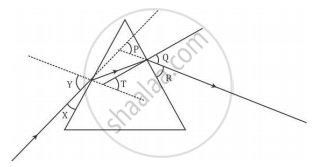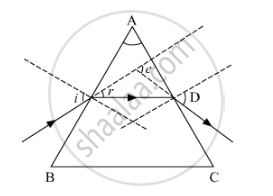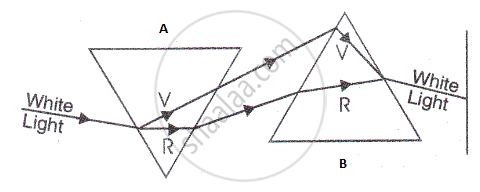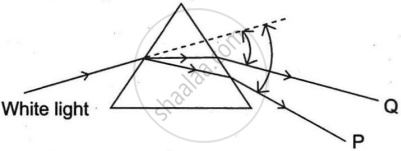Advertisements
Advertisements
Question
In the following diagram, the path of a ray of light passing through a glass prism is shown:

In this diagram the angle of incidence, the angle of emergence and the angle of deviation respectively are (select the correct option):
(A) X, R and T
(B) Y, Q and T
(C) X, Q and P
(D) Y, Q and P
Solution
The angle made by the incident ray with the normal to the first face of the prism is called incident angle, which is angle Y here.
The angle made by the emergent ray with the normal to the surface when it comes out from the prism after refraction is called emergent angle, which is angle Q here.
The angle between the incident ray and the emergent ray is called angle of deviation, which is angle P here.
Hence, the correct option is D.
APPEARS IN
RELATED QUESTIONS
Study the following figure in which a student has marked the angle of incidence (∠i), angle of refraction (∠r), angle of emergence (∠e), angle of prism (∠A) and the angle of deviation (∠D). The correctly marked angles are

(a) ∠A and ∠i
(b) ∠A, ∠i and ∠r
(c) ∠A, ∠i, ∠e and ∠D
(d) ∠A, ∠i, ∠r and ∠D
Out of the following, the colour of light having the maximum wavelength is:
(a) violet
(b) indigo
(c) green
(d) orange
In an experiment to trace the path of a ray of light through a triangular glass prism, a student would observe that the emergent ray
(a) is parallel to the incident ray.
(b) is along the same direction of incident ray.
(c) gets deviated and bends towards the thinner part of the prism.
(d) gets deviated and bends towards the thicker part (base) of the prism.
Complete the ray diagram given below to show the nature of light produced on the screen.
The completed ray diagram is as shown below:

What do you understand by spectrum? Name the seven prominent colours in order, as obtained in the spectrum of white light.
The splitting of white light in to seven colors is called ______.
Say TRUE or FALSE
After passing through a prism, white light splits into a band of seven colours
Assertion: We can see the rainbow in the sky when the rain starts falling after a spell of bright sunlight.
Reason: The rainbow is formed due to the dispersion of light.
The dispersive powers of flint glass and crown glass are 0.053 and 0.034, respectively and their mean refractive indices are 1.68 and 1.53 for white light. Calculate the angle of the flint glass prism required to form an achromatic combination with a crown glass prism of refracting angle 4°:
In the following diagram showing dispersion of white light by a glass prism, the colours 'P' and 'Q’ respectively are:

